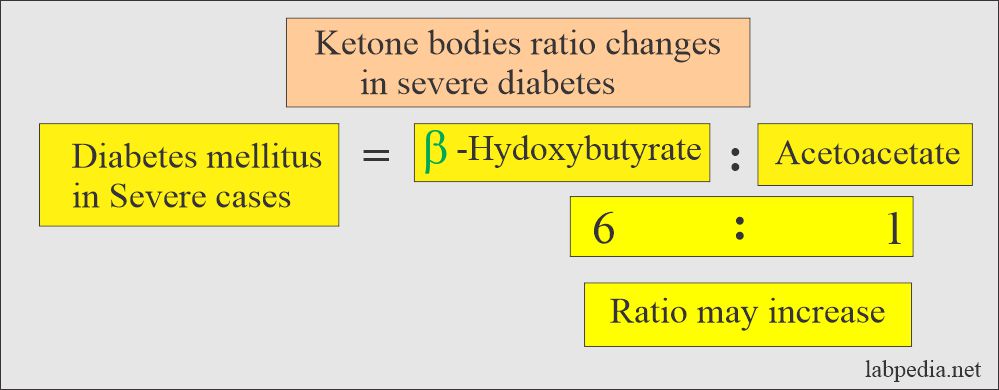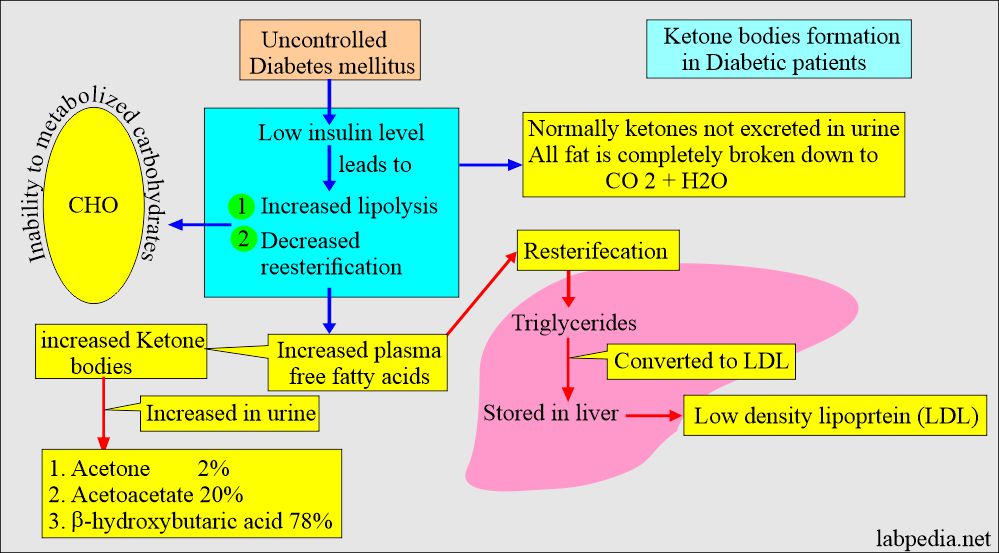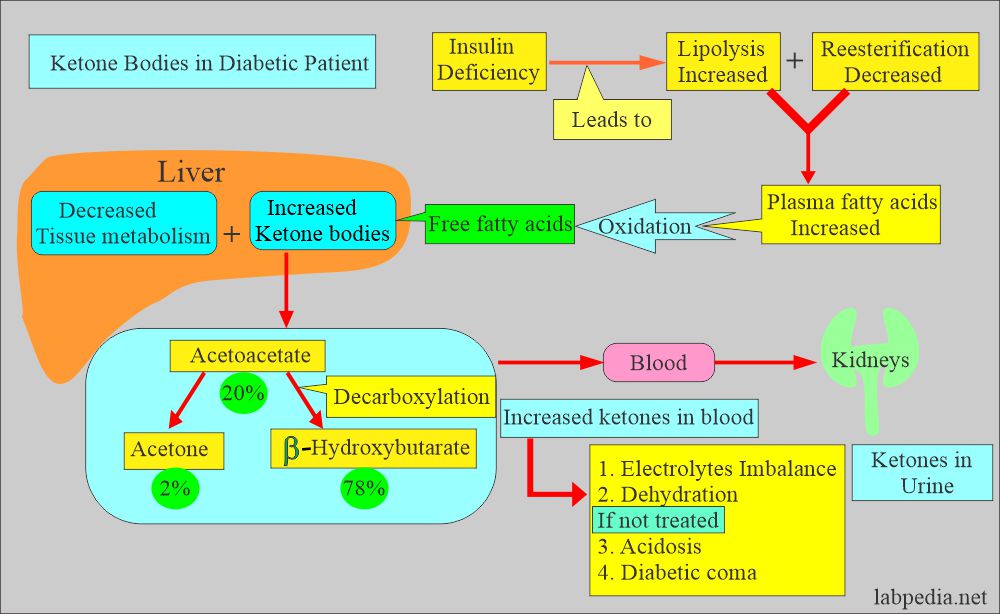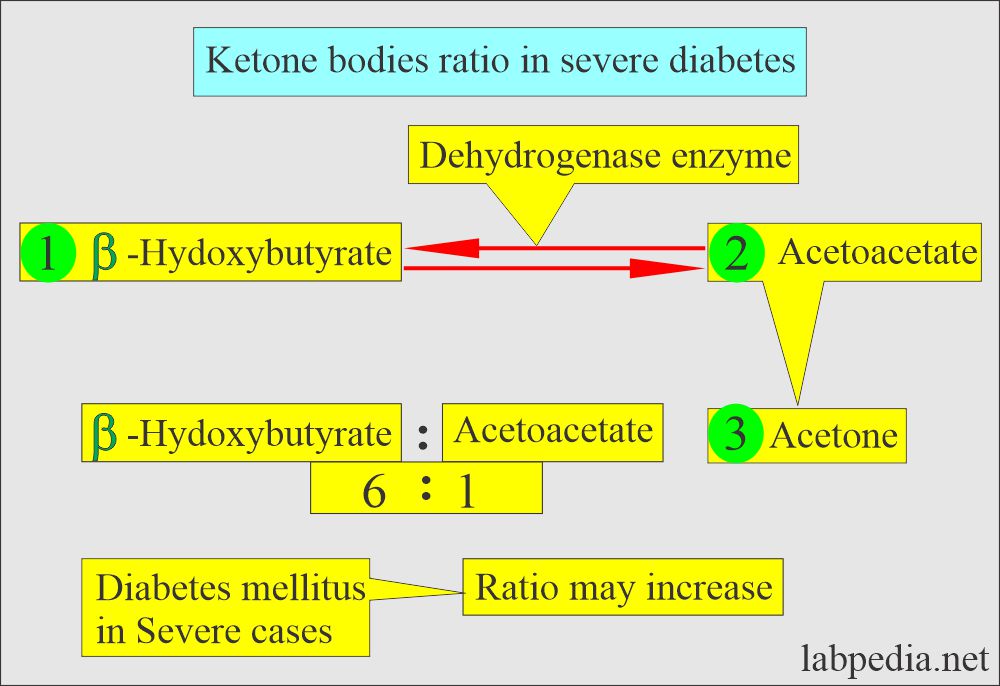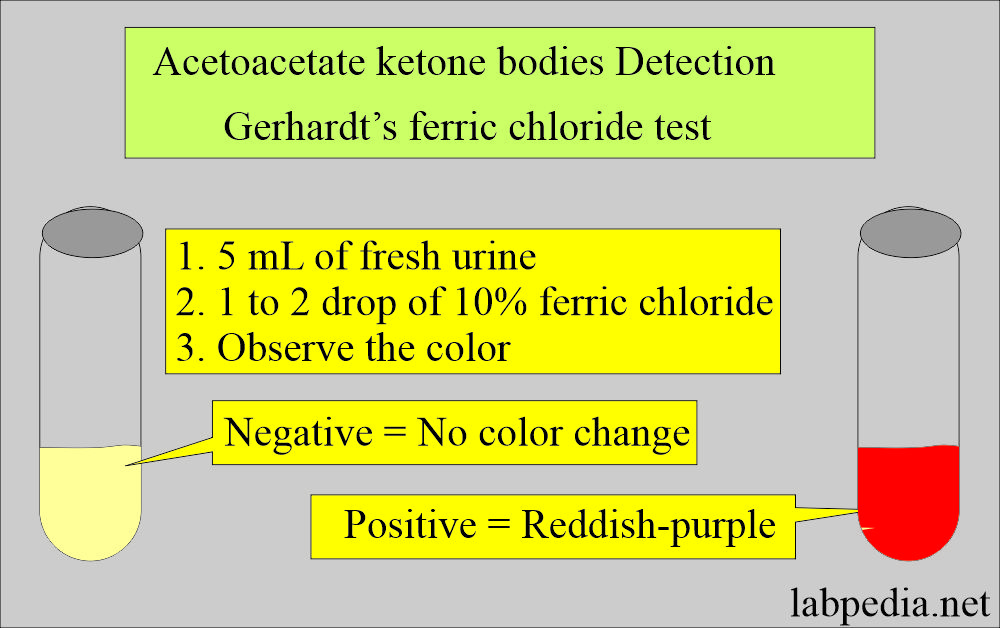Urine for ketones, and Ketone Bodies (Ketonuria)
Urine for ketones (Ketonuria)
What sample is needed for Urine for ketones?
- This is done in the urine.
- This test can also be done on blood (serum or plasma).
What are the precautions for Urine ketones?
- Keep the urine refrigerated and in closed containers.
- Avoid loss due to evaporation and bacterial action.
- Keep the blood also refrigerated.
- Some of the drugs give false-positive results, e.g.
- Phenothiazine.
- Ether and chloroform.
- Metformin.
- Captopril.
- Insulin.
- Levodopa.
- Penicillamine.
- Isopropyl alcohol.
- Valproic acid.
- Aminosalicylic acid.
- The false-negative result is seen in the following:
- When urine is kept at room temperature for a long time due to the loss of ketones in the air.
- Aspirin.
- Phenazopyridine.
What are the indications for Urine ketones?
- It is advised in diabetic patients for the early diagnosis of ketoacidosis.
- Ketones are used to judge the acidosis’s severity and monitor the treatment response.
- Testing of ketonuria in diabetetics:
- To evaluate the diabetic patient in a coma.
- To monitor people with diabetes who are on oral hypoglycemic drugs.
- Check when the patient is switched from insulin to oral hypoglycemics; ketonuria that appears within 24 hours of the insulin withdrawal indicates a poor response to oral hypoglycemic drugs.
- Testing of the ketonuria is important In patients who have urine sugar positive and raised blood glucose.
- Ketonuria is done to differentiate between diabetic coma with positive ketones and insulin-shock negative ketonuria.
- This is done by screening ketonuria, which is usually seen in hospitalized patients, children, pregnant women, and patients with diabetes.
- During pregnancy, early detection of ketonuria is essential because ketoacidosis may lead to the fetus’s death.
- It is done to judge the severity of the acidosis and the treatment response.
- Ketonuria may provide a more accurate indicator of acidosis than blood testing.
- This is helpful in the emergency wards.
How will you define Ketone bodies?
- Increased ketone bodies in the blood are called Ketonemia.
- Increased excretion in the urine is called Ketonuria.
How will you discuss the pathophysiology of ketone bodies?
- Fat metabolism, when completely metabolized, leads to CO2 and H2O formation. So, ketone bodies are not seen in the urine.
- While intermediate products are ketone bodies.
What are the conditions where you will see Ketone bodies?
- In the case of decreased availability of carbohydrates, like starvation or frequent vomiting.
- Another possibility is decreased utilization of carbohydrates, such as diabetes mellitus and glycogen storage disease.
- High-fat and low-carbohydrate diets are ketogenic and increase ketone bodies in the blood.
- Ketones are the end product of fatty acid metabolism.
How will you explain Ketone bodies in diabetic patients?
- Ketones are formed when glucose as a source of energy is not present.
- This situation happens when there is no insulin, so glucose cannot enter the cells.
- In that case, ketone bodies are the energy source for the body, particularly the brain.
- In fasting for 3 to 4 days, the ketone bodies provide 30% to 40% of body energy.
- Ketone bodies are the end product of fatty acid breakdown and consist of :
- Beta-hydroxybutyric acid.
- Acetoacetic acid.
- Acetone.
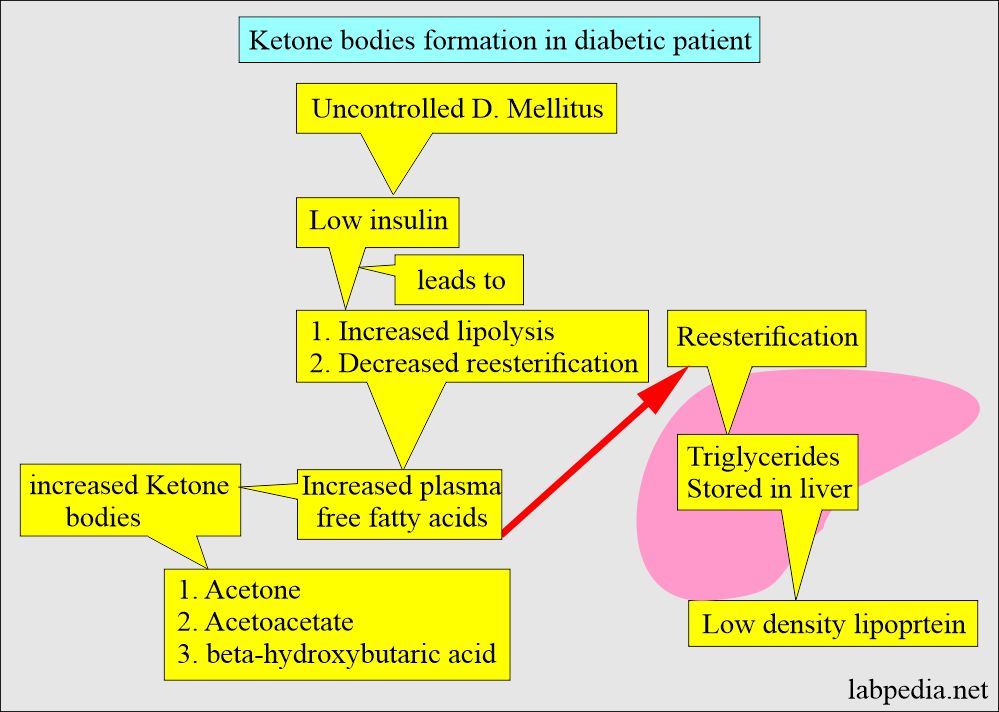
Ketone bodies in diabetic patients
- The β- hydroxybutyric acid + acetoacetic acid readily converts to acetone.
- It shows that the main ketone is acetone to be tested.
- Some of the kits only measure acetoacetic acid.
What are the types of ketone bodies?
- Acetone is a minor amount.
- Acetoacetate and β- hydroxybutyrate are equal in amount and are the main ketone bodies.
- Ketones are formed in the liver and completely metabolized in a healthy person, but a negligible amount is in urine.
What is the outcome of increased Ketone levels in the blood?
- Electrolyte imbalance.
- Dehydration.
- If not corrected, then it leads to acidosis, coma, and ultimately death.
- Ketones are present in the urine when a threshold level exceeds the blood’s normal level.
What is the clinical significance of ketone bodies?
- Insulin dosage for monitoring and managing insulin-dependent diabetes mellitus, type 1 diabetes.
- Ketonuria shows insulin deficiency and needs to adjust the dose of insulin.
- This is an early sign of an insufficient dose of insulin.
- Diabetic acidosis (Inability to metabolize carbohydrates).
- Vomiting (increased loss of carbohydrates).
- Starvation (inadequate carbohydrate intake).
- Malabsorption (inadequate carbohydrate intake).
- Pancreatic diseases.
- Inborn error of amino acid metabolism.
- Ketonuria shows a deficiency of insulin and indicates the regulation of insulin dose.
- Strenuous exercise leads to ketonuria due to the overuse of carbohydrates.
What are the normal ketone bodies in urine?
- In Urine:
- Ketone bodies are negative.
- Small amount = <20 mg/dL.
- Moderate amount = 30 to 40 mg/dL.
- Large amount = >80 mg /dL.
- In blood or plasma:
- Acetone = < 2.0 mg/dL (<0.34 mmol/L).
- Acetoacetate = < 1 mg/dL (<0.1 mmol/L).
- β-hydroxybutyric acid = 0.21 to 2.81 mg/dL (20 to 270 µmol/L).
Source 1
- Urine:
- Acetoacetate = Negative.
- Acetone = 0.3 mg/dL (0.05 mmol/L).
- β-hydroxybutyric acid = Negative
Serum or plasma ketone bodies
- Acetone
- Ketoacidosis = 10 to 70 mg/dL (1.72 to 12.04 mmol/L)
- Occupational exposure = <10 mg/dL (<1.72 mmol/L)
- Toxic concentration = >20 mg/dL (>3.44 mmol/L)
- Acetoacetate = Negative <1 mg/dL (<0.1 mmol/L)
- β-hydroxybutyric acid = 0.21 to 2.81 mg/dL (20 to 270 µmol/L)
How will you diagnose ketone bodies?
- Various types of strips are available to detect the ketone bodies.
How will you explain Gerhardt’s Ferric chloride?
- It reacts only with Acetoacetate.
- This is an indirect method of detecting the β-hydroxybutyrate in the urine.
- Nitroprusside has 10 times more sensitivity to acetoacetate than acetone.
- Acetoacetate (acetone) + sodium nitroprusside + glycine →→ purple color
- There is no reaction with β- hydroxybutyrate.
- It is reported as follows:
- Negative.
- Moderate.
- Large amount OR as
- 1+, 2+, 3+.
How will you explain the Strip method for urine ketone bodies?
- There are strips to detect β- hydroxybutyrate in the serum and urine are available.
- Quantitative estimation of β- hydroxybutyrate in serum or blood kits is commercially available.
How will you compare various test strips for the detection of ketone bodies?
| Type of the test strip | Specificity | Sensitivity |
|
|
|
|
|
|
|
|
|
|
|
|
What are the causes of Ketone bodies?
- Diabetic patients.
- Starvation.
- Fasting.
- High protein diet.
- Alcoholism.
- Salicylates poisoning.
- Isopropanol intake.
- Acute febrile illness (especially in infants and children).
- Renal Glycosuria.
- Glycogen storage disease (Von Gierke’s disease).
- Anorexia.
- Low carbohydrate diet.
- Pregnancy or lactation.
- Eclampsia.
- Fever.
- Hyperthyroidism.
- Prolonged vomiting and diarrhea.
- Patients in the hospital may have ketonuria—roughly 15% show ketonuria in hospitalized patients without diabetes.
- Ketonuria may develop after anesthesia with ether and chloroform.
- Children are more prone to develop ketonuria and ketosis.
What is the critical value of ketonuria?
- When ketonuria is positive, clinical action should be taken, and don’t take it lightly.
- Ketonuria positive in infants <2 years of age is a serious and critical alert.
- In diabetic patients, ketonuria positive means that diabetes is uncontrolled.
- In non-diabetics, it suggests increased Fat intake and fewer carbohydrates.
Questions and answers:
Question 1: What is the ratio of ketone bodies?
Question 2: Does ketone bodies are seen normally in the urine?



